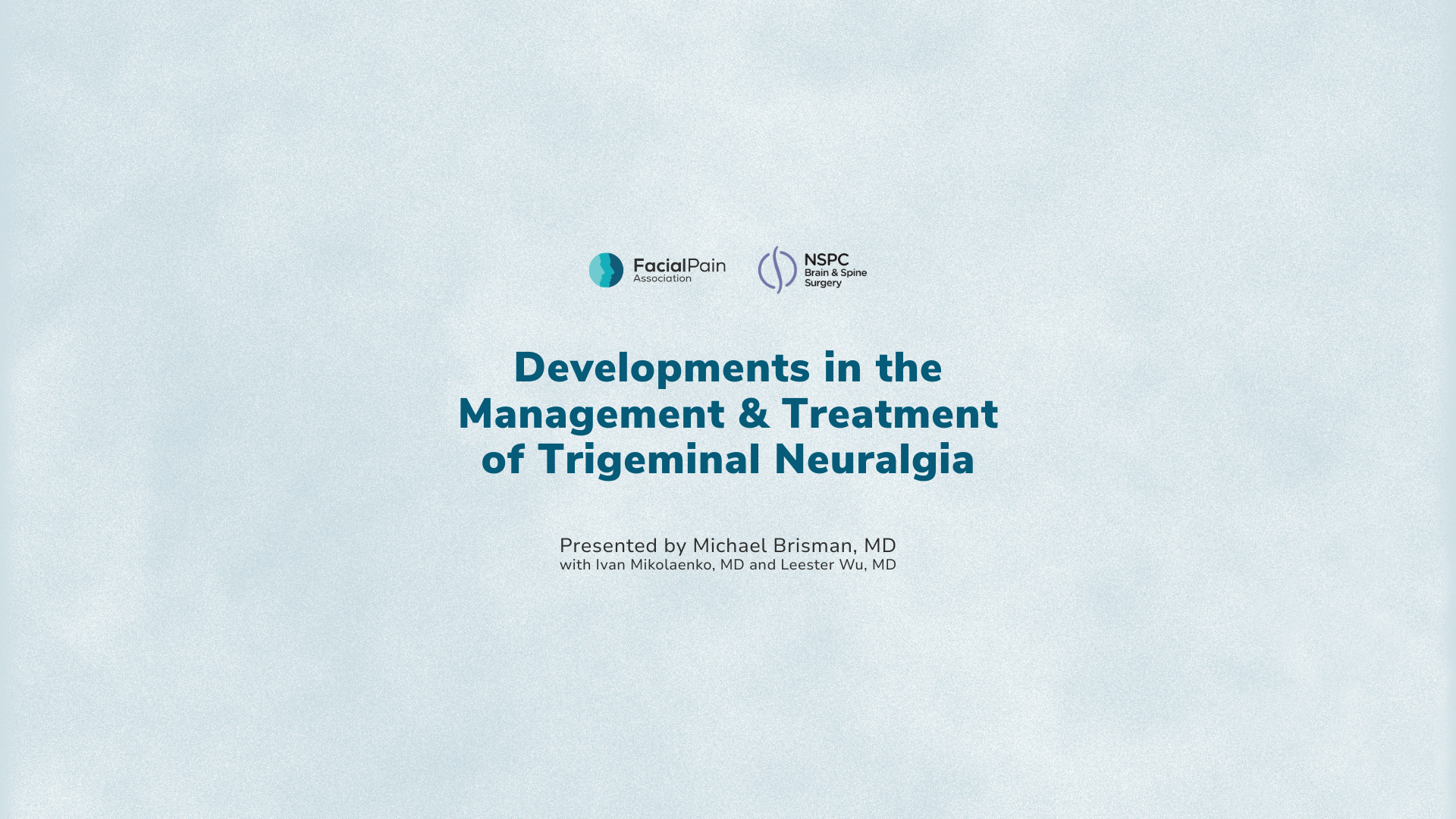Mark Linskey, MD
Dr. Linskey is a Professor of Neurological Surgery at UC Irvine in California. He is also the previous Western Regional Director of the Medical Advisory Board of the Facial Pain Association, the “Smart Medicine” training module editor for the Trigeminal Neuralgia module for the American College of Physicians, and an Editor for the British Medical Association, British Medical Journal, “Clinical Evidence” manual module on Trigeminal Neuralgia.
Before we begin, it is important to note that in this article we are not focused on all forms of trigeminal neuropathic pain. In our practice we divide neuropathic pain into typical” and “atypical” varieties. When we use the term “typical” neuropathic pain we are specifically referring to pain that is sudden in onset and resolution, lasts seconds to minutes, is described as intense sharp, stabbing or electric in character and is not associated with pain between the episodes. When we use the term “atypical” neuropathic pain we are specifically referring to pain that is described as dull, aching, burning, throbbing and/or pressure in character. It may be present only intermittently, present all the time, or present all the time with intermittent severity “flares.” In our practice we view trigeminal neuropathic pain as falling on a continuous spectrum where the patient’s position on that spectrum can change over time with syndrome evolution as well as effects of therapeutic interventions (Figure 1).

On one end of the spectrum we define “classic TN” as consisting of typical neuralgic pain only. We then define two hybrid syndromes where both types of neuralgic pain are present, but in different dominance ratios (typical pain >51% – TN1, and atypical pain >51% – TN2). We then define two syndromes on the other end of the clinical spectrum where only atypical pain is present (no typical pain component). The first where the atypical pain is intermittent with pain-free episodes present, we define as “Atypical TN”. The second where some atypical pain is always present we refer to as “Trigeminal Neuropathic Pain of Unknown (or obscure) Etiology (TNPUE).”1 The interventions described in this article are focused on acute crises of typical trigeminal neuralgic pain. That means that they will predictably work best for patients with classical TN and for the typical pain components of their syndrome for patients with either hybrid syndrome of TN1 or TN2. While patients with atypical neuralgic pain also have severe acute pain flares, the interventions described herein are less likely to help this type of pain which often requires standard pain pharmacological interventions such as narcotics, and more recently, ketamine.
Standard treatments that are the mainstay for treating patients with pain in general include, among others, acetaminophen (Tylenol), non-steroidal anti-inflammatory drugs (NSAIDS), narcotics and ketamine. All of them can now be administered both orally and intravenously. These medications may prove useful for treating acute flares of atypical trigeminal neuralgic pain. However, one of the unique characteristics of typical trigeminal neuralgic pain is that it generally does not respond well to these agents.
One of the unique features of typical trigeminal neuralgic pain is that it characteristically responds best to anti-epileptic drugs (AED) treatment. These typically include the first line TN agents in the carbamazepine family including Tegretol and oxcarbazepine (Trileptal) as well as agents in the Gamma Aminobutyric Acid (GABA) analogue family which includes gabapentin (Neurontin) and pregabulin (Lyrica). Unfortunately these agents suffer from several major drawbacks during an acute flare of typical trigeminal neuralgic pain:
- First, TN is characterized by tactile triggers in the trigeminal nerve innervation distribution, and these agents can only be administered orally. If opening your mouth, taking pills, having liquid in your mouth, or swallowing are tactile triggers for a given patient, they may not be able to take the medication orally.
- Second, these agents have pharmacokinetic half-lives that require several days of consistent oral dosing for drug levels to reach a steady state. The longer tactile trigger concerns lead to missed oral doses, the lower the circulating blood levels get and the worse the acute pain flare becomes. It becomes an accelerating “vicious circle” over time.
- Third, Even if the patient could somehow take the medication orally during the acute crisis, depending on how many doses had already been missed, the medication may take too long, or take too many doses over time, for an effective blood steady state level to be re-achieved.
What is needed to break the acute typical trigeminal neuropathic pain crisis are AEDs that can be administered intravenously (IV) in a loading dose that can immediately achieve a therapeutic drug level. The mainstay and most proven IV agent for TN is phenytoin (Dilantin) and now its newer cousin fosphenytoin (Cerebyx). Phenytoin has a long history of use in TN and in fact was the first AED to be shown to be effective for TN.3,4 It can be loaded to full therapeutic drug blood level if administered intravenously over 20-60 minutes with telemetry monitoring for safety reasons for possible cardiac heart rhythm and hemodynamic blood pressure effects. Fosphenytoin is newer and safer to load and along with phenytoin has been effectively used for acute attacks of typical trigeminal neuropathic pain.5-7 Once the pain cycle is broken by intravenous drug load administration, the patient can once again resume taking their better oral AED medications and “catch up” with re-establishing therapeutic blood levels of these better drugs. If additional time is needed for several oral AED doses to occur, the intravenous medication can be continued in a therapeutic maintenance dose regimen until the oral dosing/blood level goal is achieved, and the patient can then be sent home on their oral drug regimen.
It is also important to point out that patients who are in typical trigeminal neuropathic pain crisis where they cannot open their mouth, take pills, eat or drink, may also turn out to be significantly dehydrated by the time they finally resolve to go to the ER. In this setting intravenous hydration may also be an important component of helping to resuscitate them and helping them to feel better.
While there are no studies to date to assess their effect on an acute crisis of TN, we are constantly developing new AED’s for epilepsy. Two of these are of potential interest for the management of patients who are in typical trigeminal neuropathic pain crisis because they cannot only be administered intravenously, but can be fully loaded with the initial intravenous dose. These medications are levetiracetam (Keppra) and lacosamide (Vimpat). While neither has been properly evaluated yet for treating TN, as AED’s they retain that theoretic potential, and as drugs that can be loaded rapidly intravenously, they may be worth trying in the setting of trigeminal neuropathic pain crisis. This may be particularly relevant for patients who are allergic to phenytoin or fosphenytoin. An empiric trial of intravenous loading of one of these two agents if phenytoin or fosphenytoin do not work or cannot be administered due to drug allergy would seem to be a reasonable (though unproven) empiric option in these circumstances.
For patients with TN, we recommend that you carry with you, on your person at all times (wallet, purse, or cell phone), a sheet of paper or card that you can show to an ER healthcare provider if you are in such acute pain crisis that you cannot talk without triggering a pain attack. Below, we are also including a summary that you can/should also take with you to try and help in these crisis situations for communicating with your ER healthcare provider. I sincerely hope that these prove useful.
Disclaimer: This article discusses medical diagnoses and potential therapeutic interventions. It is intended for educational and background reference purposes only. It is not intended to prescribe any specific course of care or treatment. Actual care and/or treatment must always be prescribed by an appropriately licensed health professional in direct consultation with their patient in the setting of that specific patientphysician relationship taking into account their specific circumstance, as well as the risks and benefits of any intervention, which should be mutually reviewed and agreed upon onsite at that time.
Recommendations For Urgent/Emergent Care Of Patients With an Acute Attack of Neuropathic Pain from Trigeminal Neuralgia
Patient Advice:
If you are experiencing an acute trigeminal neuralgic pain symptom attack, remember that narcotics usually will not work to relieve your pain. Furthermore, you may not be able to take your prescribed oral antiepileptic-anticonvulsant drugs (opening or touching your mouth may be a tactile pain trigger). In addition you may have missed one, or more, doses for this reason and your blood stream drug levels may have dropped as a result. Finally, even resuming these drugs may not help in the short-term since they enter your system too slowly. In an emergency, notify your treating physician and then seek medical attention at a local hospital that treats your condition.
To the Senior Emergency Room Physician:
The key drug to use is an anticonvulsant that can be loaded to full therapeutic blood levels intravenously (IV). Phenytoin (Dilantin) was the first anti-epileptic drug (AED) shown to work for trigeminal neuralgia (TN). Deliver a 1 gram load IV over 20-60 minutes with telemetry cardiac and blood pressure monitoring. This will break the acute pain cycle 90% of the time. Alternatively fosphenytoin (Cerebyx) may be used (1 gram phenytoin equivalent load) under the same monitoring conditions. Once the pain cycle is broken the patient can resume taking their better oral AED medications and you can even consider taking 1-2 extra doses, on a one-time basis, to catch up if they have previously missed a significant number of doses. If they are allergic to phenytoin or these medications do not work, two other AED’s (levetiracetam [Keppra] and lacosamide [Vimpat]) can be loaded IV and might help. They have not been tested and proven for treating TN, but they are in the same therapeutic drug class and can be safely loaded IV.
Key Points:
Neuropathic pain generally does not respond to standard analgesics including opiods (narcotics).
It is usually managed with PO AED’s that can take days to achieve therapeutic drug levels.
The patient has come to you because they are in acute neuropathic pain crisis, may have missed several PO AED doses as well as be unable to take PO AED’s in your ER due to oral tactile pain triggering, or may not be on the right medication to start with (usually carbamazepine, oxcarbazepine, gabapentin, pregabulin, baclofen, or a combination).
Immediate Action Required:
Plan A: administer a 1 gram load of phenytoin IV over 20-60 minutes with telemetry cardiac and blood pressure monitoring (alternatively fosphenytoin may be used – 1 gram phenytoin equivalent load)
Plan B: administer a 1000mg load of levetiracetam IV over 5 minutes with telemetry cardiac and blood pressure monitoring
Plan C: administer a 200-400mg load of lacosamide IV with telemetry cardiac and blood pressure monitoring
Summary:
If the acute attack does not respond to an IV load of phenytoin or fosphenytoin, then it is reasonable to consider levetiracetam or lacosamide as alternatives in similar drug classes that can be safely loaded IV. Once the pain cycle is broken the better PO AED’ s can be resumed.




















































































